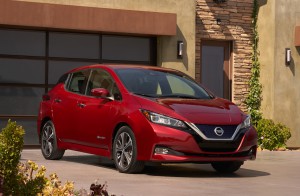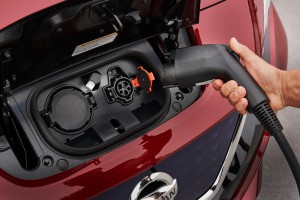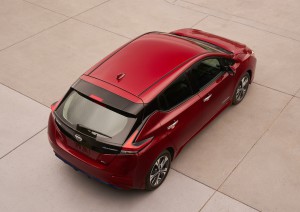
The second-generation Nissan Leaf offers more horsepower and nearly double the range of its predecessor.
Most anyone who has driven a modern electric car acknowledges that they are fun to drive with solid ride and handling and the kind of pickup from a standing start that can match a good old-fashioned muscle car.
With the introduction of the second generation all-electric Leaf, perhaps the most successful and popular electric vehicle on the market in the past decade, Nissan is doubling down on the fun-to-drive component of EVs, even as it extends its range and adds new technology into the car, while maintaining what it describes as an affordable price, which starts at $29,990 before adding in the $885 destination charge.
At its heart, the 2018 Leaf’s electric powertrain has been upgraded. The new Leaf carries a 40-kilowatt battery with a range 150 miles, which translates into a 40% improvement over the previous generation vehicle and opens the door to longer commutes and reducing driver anxiety. The new e-powertrain is rated at 147 horsepower and 236 foot-pounds of torque, providing improved acceleration and seat-of-the-pants driving enjoyment.
The zero-to-60 speed has improved by 15%, and the mid-range acceleration by 30%, although they offered no specific numbers. Nissan officials also confirmed during the ride and drive that the Japanese automaker will offer a 60-watt battery for the Leaf’s powertrain in 2019, elevating the both the horsepower and range. The new range will be a competitive 225 miles. That puts it in the same class as the Chevy Bolt and Tesla Model 3.
(Nissan expects 2018 Leaf to turnover new buyers. For the story, Click Here.)
Charging remains the Achilles Heel of EVs and the Leaf still requires 16 hours to recharge using a 120-Volt outlet and 8 hours, using a 240-volt outlet. A fast charge station can re-charge the Leaf’s battery to about 80% charge in about 40 minutes.
The Leaf’s low center of gravity, coupled with a redesigned suspension, improve the Leaf’s overall ride and handling, which is very solid. The electric power steering smooth and precise, while the regenerative braking system helps gives the car additional stopping power.
Nissan re-engineered the chassis for greater stability. Heavy components, including the battery, are placed in the center of the body, helping achieve greater stability compared with front-engine vehicles and improving directional stability for smoother cornering.
Nissan is also offering some new technology on the 2018 Leaf, dubbed “e-Pedal,” that improves the brake performance and will help make the car more fun to drive. It allows the drivers to accelerate, deaccelerate and stop using just one pedal. The system allows the drivers to bring the car to a complete stop on a slope and drive instantly when the foot comes off the pedal.
(Click Here for more about Nissan’s ProPilot autonomous technology.)
Studies in Japan, Europe and the U.S. have shown that the e-Pedal reduces the number of times the driver must apply the brakes while commuting in heavily congested traffic. While the conventional brake pedal must still be used in aggressive braking situations, the e-Pedal lets drivers use a single pedal for more than 90 percent of their driving needs, according to Nissan.
The other system, incorporated into the Leaf, ProPilot Assist, will keep the car in the middle of highway by reading lane markers, while controlling the speed for traffic conditions and steering the car through drivers. The system does require drivers to keep their hands on the wheel and it is not and should not be considered fully autonomous.
The exterior design of the new Leaf features low profile and includes a number of Nissan’s unique design cues including the boomerang-shaped head light and front grille. Designers have also emphasized the car’s aerodynamics, emphasizes the exhilaration of driving an EV.

The 2018 Nissan Leaf nearly doubled its driving range to 145 miles, but a new battery pack coming for 2019 will push that to 225 miles.
The new interior of the Leaf offers plenty of space for driver and passenger and the overall ambience are enhanced by the choice of materials, which are nicely blended. The simple lay out of the instrument panel, center console and screen and the 7-inch, full-color TFT display, which was redesigned to make it easier to read and to accommodate the signals from ProPilot. Apple CarPlay and Android Auto have also been added to the telematics system.
The 2018 Leaf demonstrates rather forcefully that battery electric vehicles have continued to evolve and mature into automobiles that are a pleasure to drive. They have drawbacks. I think charging and recharging is an even bigger issue than range. But anyone who derides today’s EVs as glorified golf carts isn’t paying attention.
(To see more about Nissan’s future electrification plans, Click Here.)
Indeed, they nothing like a golf cart or one of carts that old folks use to putter around a retirement villages somewhere in Florida or Arizona.


